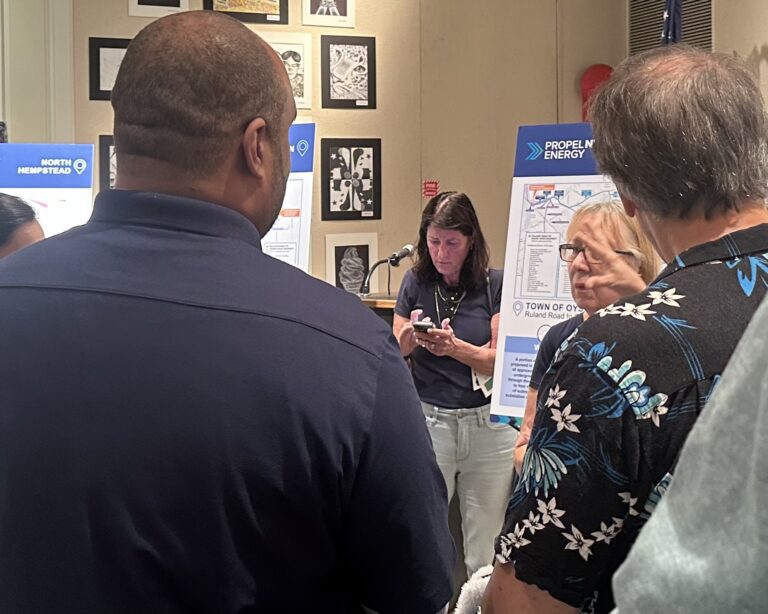
Residents and environmental activists expressed support for a transmission line project proposed for Long Island that will bolster energy sustainability but are calling for measures to ensure environmental harm is mitigated once implemented.
“The state needs to move to renewable energy and has to increase the energy production and not produce it by fossil fuels,” Coalition to Save Hempstead Harbor board member Kay Bromberg said. “It’s just the situation today where every household demands more energy and it’s not going down.”
Community members gathered at the Bryant Library in Roslyn on Tuesday evening for an open house hosted by the New York Power Authority and New York Transco – the leaders of the transmission line project.
George Povall, executive director of renewable energy and environmental protection organization All Our Energy, said it is important for New York Power Authority and New York Transco to be transparent with residents and foster conversations with the community. He said they are moving in the right direction in promoting this.
The Propel New York Energy project proposal calls for about 66 miles of electrical transmission lines throughout Long Island, with a majority proposed in Nassau County.
The project includes the implementation of new and upgraded electrical stations along with nearly 90 miles of underground and submarine – or below the sea floor – transmission lines.
A majority of the lines will be placed on Long Island, with just 12 miles in New York City and 12.6 miles in Westchester County.
Nearly 10 miles of submarine lines will also be installed, cutting through Hempstead Harbor and the Long Island Sound. Of this, 6.25 miles will be considered part of Long Island.
The project is a collaboration between the New York Power Authority, the state’s public power utility, and New York Transco, a developer, owner, and operator of bulk electrical transmission facilities in New York.
Its intent is to bolster reliability, resiliency and redundancy in the electrical grid and aid in environmental sustainability goals.
Margaret Galbraith, president of an environmental action group, Transition Town Port Washington, said something needs to be done to address climate change and that sustainable energy options are the right direction.
Barbara Holzkamp, a member of the Coalition to Save Hempstead Harbor and the Glenwood Landing Glead Head Civic board, said she is trying to be open-minded about the project but has concerns.
Holzcamp said her main concern was the installation of transmission cables in the harbor, which she said could potentially have negative environmental impacts on the ocean floor environment.
“We have been working for years to get it better, the population cleaned up,” Holzcamp said. “They’ve been seeding oysters in there and now they’re going to put huge cables in there.”
Bromberg said the project could harm the environment if not done properly, but it can also foster beneficial environmental impacts. She said this would be achieved through the project’s utilization of renewable energy.
Shannon Baxevanis, New York Transco director of communication and public affairs, said the project will go under a “robust” environmental review during its permitting process and is required to provide environmental reports. She said environmental agencies will review the project as well.
Once permits are awarded, Baxevanis said conditions will be attached to the project to protect the environment and monitoring will occur during the project to ensure they are adhered to.
Hildur Palsdottir, a community energy educator with Cornell Cooperative Extension, said there are ways to mitigate environmental harm and opportunities to foster environmental growth.
Palsdottir offered suggestions, including active reforestation when closing the trenches to install the transmission lines. She said that closing the trenches is an opportunity for urban greening and planting native plants in those areas.
The transmission lines are planned to be placed under existing public rights of way and utility properties throughout Nassau County and in Suffolk County, Queens, the Bronx and Westchester County.
Three segments of the transmission lines route will run through North Hempstead on Northern Boulevard, Mineola Avenue to Willis Avenue, and Glen Cove Road.
In Nassau County, most of the lines will run through the Town of North Hempstead and cut through 11 villages. Approximately 19.5 miles of lines will be installed in North Hempstead.
These lines would cut through the villages of Westbury, Old Westbury, East Hills, Roslyn Harbor, Mineola, Williston Park, Roslyn, Flower Hill, Lake Succes, Russell Gardens, and Thomaston.
The project is in its pre-permitting outreach and survey phase, during which it will solicit community and municipality feedback on the project. This is a required component before permits can be applied for.
The application for a state permit to begin the project is anticipated to be filed this summer, but the process is estimated to take place through 2026. It is estimated that the permitting process will take about two years.






